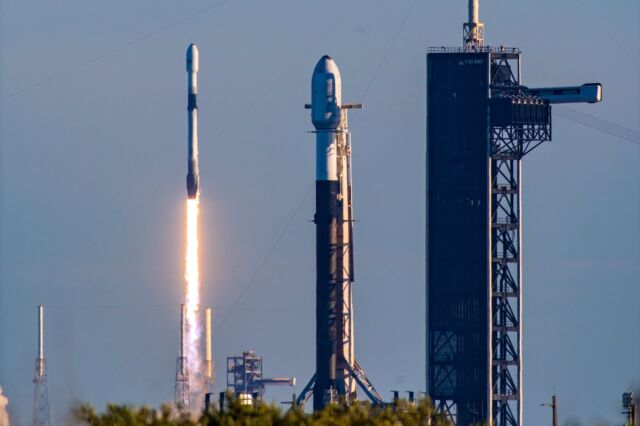
A strategy document released by the Pentagon this week lays out where the US military can most effectively rely on the commercial space industry and what missions should remain in government hands.
"This marks a new effort to harness the remarkable innovation of the commercial space sector to enhance our resilience and strengthen integrated deterrence as a department," said John Plumb, assistant secretary of defense for space policy.
The Space Force already buys a lot from the commercial space industry. The military doesn't build or own satellite launch vehicles—those come from commercial companies. While the Space Force operates government-owned reconnaissance and surveillance satellites, it also buys supplementary data and imagery from the commercial industry.
"To protect our men and women in uniform and to ensure the space services they rely on will be available when needed, the department has a responsibility to leverage all tools available, and those tools include commercial solutions," Plumb said Tuesday. "From launch to space domain awareness to satellite communications and more, the commercial sector’s ability to innovate, to scale production and to rapidly refresh their technology is opening the door to all kinds of possibilities."
The Pentagon defines the commercial space sector as companies that develop capabilities for sale on the commercial market, where the military is one of many customers. This is separate from the Pentagon's procurement of government-owned airplanes and satellites from the defense industry.
Ripe for exploitation
Build or buy is an age-old question facing everyone from homeowners to billion-dollar enterprises. When it comes to space, the Pentagon is buying more than ever. The military's new strategy document outlines 13 mission areas for national security space, and while the commercial space industry is rapidly growing, the Pentagon predominately buys commercial services in only one of those mission areas.
Advertisement"Out of those 13, the only that’s clearly primarily commercial now is SAML.. which is Space Access, Mobility and Logistics, and space access is launch," Plumb said. "So SpaceX, Firefly, Rocket Lab, all these different companies doing commercial launch, that’s where the commercial sector clearly can provide services."

Currently, the military classifies six mission areas as a hybrid of government and commercial capabilities:
- Cyberspace operations
- Satellite communications
- Spacecraft operations,
- Intelligence, surveillance, and reconnaissance
- Space domain awareness (tracking of space objects)
- Environmental monitoring.
In the remaining six mission areas, "a preponderance of functions must be performed by the government, while a select few could be performed by the commercial sector," officials wrote in the commercial space strategy. In these areas, there is not yet a viable commercial market outside of the government, or commercial capabilities don't match the government's needs. These areas include:
- Command and control (including nuclear command, control, and communications)
- Electromagnetic warfare
- Nuclear detonation detection
- Missile warning
- Position, navigation, and timing (GPS).
A major tenet of the commercial space strategy is for the military to support the development of new commercial space capabilities. This could involve supporting technology demonstrations and funding scientific research. Over time, new technology and new markets could bring more mission areas into the hybrid or commercial lists.
"I think what this strategy hopes to do is say, yes, continue working on bringing commercial entities in," Plumb said. "This is actually a thing we want you to do, not just a thing you should be experimenting with.”
The devil is in the details
This commercial space integration strategy is the first of its kind to be put in writing. The document focuses on high-level guidance, not detailed prescriptions, but in broad strokes, it provides a roadmap for how the Pentagon will incorporate more commercial capabilities into the military's space architecture. It also addresses, but doesn't fully answer, fundamental questions about how the US military will treat commercial satellites, rockets, or related infrastructure in wartime.
There are several unresolved issues here. Will commercial satellites under contract to the Pentagon, like SpaceX's Starlink Internet network or spacecraft providing high-resolution surveillance, become targets for military adversaries? And what happens if those satellites are destroyed or knocked offline? Will the military conduct a retaliatory strike? Will insurance pay for the losses?
A cyber or physical attack on a space network or its support infrastructure on Earth could rob the military of important capabilities and have a significant financial cost to the system's commercial owner. Last year, Gen. Chance Saltzman, the chief of space operations in the Space Force, suggested the military has a responsibility to defend commercial assets in space.
"The US has a long history of saying we’re going to protect the things that we need to be successful," he said. "So it would stand to reason that that same philosophy would extend into space."
However, the details are complicated. "We will work to establish the security conditions necessary to integrate commercial space solutions and help commercial providers reduce risk," Plumb said. He added that the Pentagon "will always maintain the option to use military force to protect and defend commercial assets."
But the military's main lines of effort will involve creating internationally recognized norms and standards for "responsible behavior" in space, sharing threat information with commercial partners, and financial protection for companies who might suffer a loss from an attack, according to the space strategy document.

This financial protection could involve standard commercially available insurance policies. "There is also this concept of war-risk insurance, which is sometimes available on the commercial market, and there is US government-backed war-risk insurance, or just US government-backed insurance," Plumb said. "We do not have a final answer on that. The secretary [of defense] has directed that the department look at, 'Are there gaps that need to be covered by this now?'”
AdvertisementAnother option is indemnification, typically used in risky operations like space launches and nuclear activities in which the military could provide a direct payout to compensate a commercial company for a loss.
Figuring this out is not a theoretical exercise. An official in Russia's foreign ministry in 2022 said that the use of civilian satellites for wartime purposes essentially makes them valid military targets. At the time, this official was apparently referring to the Ukrainian military's use of Starlink. Since then, Russian military forces have started using Starlink in the war in Ukraine.
US officials attributed a 2022 cyberattack on the KA-SAT Internet network to Russia. The attack disrupted broadband satellite Internet access and disabled modems that communicate with the KA-SAT network, owned by the US company Viasat.
"Many systems can be used for military or for commercial," Plumb said. "What we’ve seen in the Ukraine conflict is Russia threatening commercial provider satellites, even hacking Viasat because while it’s a commercial provider, it’s also being used, or the Russians think it’s being used, for the Ukrainian battlefield.”
When asked by a reporter, Plumb declined to set a threshold for when the US military might view an attack on a commercial satellite as an act of war. “I can’t get into hypothetical red lines, but I understand your question," he said. "It’s a good question. I think I’d have to ponder that one for a bit.”
War games and innovation
It's important for the military to work out these details before any combat on the high frontier.
"We will work to achieve integration prior to crisis," Plumb said. "We want to integrate commercial space solutions in our day-to-day operations, during peacetime, so we can be ready and able to rely on those same commercial solutions during conflict.”
What does this look like? Commercial companies have asked the Pentagon to run through war scenarios with them. "We need to work to bring more commercial partners into our war games and into our training exercises, so that commercial partners also understand what will be required of them," he said.
AdvertisementA key metric military officials need to consider when deciding the build vs. buy question is how much benefit the military will receive from commercial services or how much cheaper they might be than a government solution.
"I do think right now it’s very clear across the department that the commercial sector has the ability to move at a faster speed than we can move, in many ways," Plumb said.

The Space Force is developing its own commercial space strategy, which could include more details about what kinds of services the Space Force intends to buy on the commercial market. This information is not just useful guidance for military procurement officers but also could drive investment into space companies working on projects that could be eligible for lucrative military contracts.
Last week, Saltzman said one emerging commercial space capability, SpaceX's giant Starship rocket, is something the Space Force would have never even considered before it was announced.
"I would have never written the requirements for Starship," Saltzman said. "My mental model wouldn’t frame around that kind of capacity, at that price point, at that scale. I couldn’t do it. So what we’re relying on is industry to help us innovate by showing us the art of the possible, bringing ideas to us, saying is this useful?"
If the Space Force took a top-down approach, "I’m going to get it wrong because I just won’t have the insights and the creativity that I currently see out in the commercial space industry," Saltzman said.



















